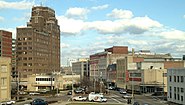Portal:Mississippi/Selected article
| This page is currently inactive and is retained for historical reference. Either the page is no longer relevant or consensus on its purpose has become unclear. To revive discussion, seek broader input via a forum such as the village pump. |
| Note: Article entries here are now being transcluded directly on the main portal page. However, this page should be retained for historical reference. |
Portal:Mississippi/Selected article/1
Meridian is a city in and the county seat of Lauderdale County, Mississippi, United States. It is the sixth largest city in the state and the principal city of the Meridian, Mississippi Micropolitan Statistical Area. Along major highways, the city is 93 mi (150 km) east of Jackson, Mississippi; 154 mi (248 km) west of Birmingham, Alabama; 202 mi (325 km) northeast of New Orleans; and 231 mi (372 km) southeast of Memphis, Tennessee. Established in 1860 at the intersection of the Mobile and Ohio Railroad and Southern Railway of Mississippi, Meridian relied heavily on the rails and goods transported on them. Rebuilt after the war, the city entered a "Golden Age", becoming the largest city in Mississippi between 1890 and 1930 and a leading center for manufacturing in the South. It had 44 trains coming in and out daily. Although its economy slowed with the decline of the railroad industry, the city has diversified, with healthcare, military, and manufacturing employing the most people in 2010. The population within the city limits, according to 2008 census estimates, is 38,232, but a population of 232,900 in a 45-mile (72 km) radius and 526,500 in a 65-mile (105 km) radius, of which 104,600 and 234,200 people respectively are in the labor force, feed the economy of the city. (Full article...)
Portal:Mississippi/Selected article/2
Cajun music, an emblematic music of Louisiana, is rooted in the ballads of the French-speaking Catholics of Canada. Cajun music is often mentioned in tandem with the Creole-based, Cajun-influenced zydeco form, both of Acadiana origin. These French Louisiana sounds have influenced American popular music for many decades, especially country music, and have influenced pop culture through mass media, such as television commercials.
The unaccompanied ballad was the earliest form of Cajun music. The narrative songs often had passionate themes of death, solitude or ill-fated love — a reaction to their harsh exile and rough frontier experience, as well as celebrations of love and humorous tales. Ballads were ritually sung at weddings and funerals, and sung informally for small groups of people at house parties as the food cooked and young children played.
In earlier years, the fiddle was the predominant instrument. Usually two fiddles were common, one playing the melody while the other provided the séconde, or back-up part. Twin fiddling traditions represent the music in its purest form, as it was brought to Louisiana with the early immigrants and before popular American tunes mingled with it. Gradually, the diatonic accordion emerged to share the limelight. The introduction of the accordion can be traced back to German Coast settlers. (read more . . . )
Portal:Mississippi/Selected article/12
Cajun music, an emblematic music of Louisiana, is rooted in the ballads of the French-speaking Catholics of Canada. Cajun music is often mentioned in tandem with the Creole-based, Cajun-influenced zydeco form, both of Acadiana origin. These French Louisiana sounds have influenced American popular music for many decades, especially country music, and have influenced pop culture through mass media, such as television commercials.
The unaccompanied ballad was the earliest form of Cajun music. The narrative songs often had passionate themes of death, solitude or ill-fated love — a reaction to their harsh exile and rough frontier experience, as well as celebrations of love and humorous tales. Ballads were ritually sung at weddings and funerals, and sung informally for small groups of people at house parties as the food cooked and young children played.
In earlier years, the fiddle was the predominant instrument. Usually two fiddles were common, one playing the melody while the other provided the séconde, or back-up part. Twin fiddling traditions represent the music in its purest form, as it was brought to Louisiana with the early immigrants and before popular American tunes mingled with it. Gradually, the diatonic accordion emerged to share the limelight. The introduction of the accordion can be traced back to German Coast settlers. (read more . . . )

